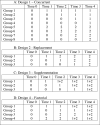Proposed variations of the stepped-wedge design can be used to accommodate multiple interventions
- PMID: 28412466
- PMCID: PMC5835387
- DOI: 10.1016/j.jclinepi.2017.04.004
Proposed variations of the stepped-wedge design can be used to accommodate multiple interventions
Abstract
Objectives: Stepped-wedge design (SWD) cluster-randomized trials have traditionally been used for evaluating a single intervention. We aimed to explore design variants suitable for evaluating multiple interventions in an SWD trial.
Study design and setting: We identified four specific variants of the traditional SWD that would allow two interventions to be conducted within a single cluster-randomized trial: concurrent, replacement, supplementation, and factorial SWDs. These variants were chosen to flexibly accommodate study characteristics that limit a one-size-fits-all approach for multiple interventions.
Results: In the concurrent SWD, each cluster receives only one intervention, unlike the other variants. The replacement SWD supports two interventions that will not or cannot be used at the same time. The supplementation SWD is appropriate when the second intervention requires the presence of the first intervention, and the factorial SWD supports the evaluation of intervention interactions. The precision for estimating intervention effects varies across the four variants.
Conclusion: Selection of the appropriate design variant should be driven by the research question while considering the trade-off between the number of steps, number of clusters, restrictions for concurrent implementation of the interventions, lingering effects of each intervention, and precision of the intervention effect estimates.
Keywords: Cluster-randomized trial; Efficiency; Multiple interventions; Pragmatic trials; Stepped-wedge trial design; Study design.
Copyright © 2017 Elsevier Inc. All rights reserved.
Conflict of interest statement
Figures



Similar articles
-
Developing Statistical Methods to Improve Stepped-Wedge Cluster Randomized Trials [Internet].Washington (DC): Patient-Centered Outcomes Research Institute (PCORI); 2021 Aug. Washington (DC): Patient-Centered Outcomes Research Institute (PCORI); 2021 Aug. PMID: 38913814 Free Books & Documents. Review.
-
Power analysis for concurrent balanced or imbalanced multiple-intervention stepped wedge design: a simulation-based approach.BMC Med Res Methodol. 2025 Apr 16;25(1):96. doi: 10.1186/s12874-025-02546-w. BMC Med Res Methodol. 2025. PMID: 40241012 Free PMC article.
-
Minimum number of clusters and comparison of analysis methods for cross sectional stepped wedge cluster randomised trials with binary outcomes: A simulation study.Trials. 2017 Mar 9;18(1):119. doi: 10.1186/s13063-017-1862-2. Trials. 2017. PMID: 28279222 Free PMC article.
-
The need to balance merits and limitations from different disciplines when considering the stepped wedge cluster randomized trial design.BMC Med Res Methodol. 2015 Oct 30;15:93. doi: 10.1186/s12874-015-0090-2. BMC Med Res Methodol. 2015. PMID: 26514920 Free PMC article.
-
Systematic review showed that stepped-wedge cluster randomized trials often did not reach their planned sample size.J Clin Epidemiol. 2019 Mar;107:89-100. doi: 10.1016/j.jclinepi.2018.11.013. Epub 2018 Nov 17. J Clin Epidemiol. 2019. PMID: 30458261
Cited by
-
Evaluating the impact of multilevel evidence-based implementation strategies to enhance provider recommendation on human papillomavirus vaccination rates among an empaneled primary care patient population: a study protocol for a stepped-wedge cluster randomized trial.Implement Sci. 2018 Jul 13;13(1):96. doi: 10.1186/s13012-018-0778-x. Implement Sci. 2018. PMID: 30001723 Free PMC article. Clinical Trial.
-
Implementing evidence-based practices to improve primary care for high-risk patients: study protocol for the VA high-RIsk VETerans (RIVET) type III effectiveness-implementation trial.Implement Sci Commun. 2024 Jul 15;5(1):75. doi: 10.1186/s43058-024-00613-9. Implement Sci Commun. 2024. PMID: 39010160 Free PMC article.
-
A multi-dimensional incomplete stepped-wedge trial design to estimate the impact of standards-based audit.PLoS One. 2023 Nov 30;18(11):e0294352. doi: 10.1371/journal.pone.0294352. eCollection 2023. PLoS One. 2023. PMID: 38032874 Free PMC article.
-
Admissible multiarm stepped-wedge cluster randomized trial designs.Stat Med. 2019 Mar 30;38(7):1103-1119. doi: 10.1002/sim.8022. Epub 2018 Nov 6. Stat Med. 2019. PMID: 30402914 Free PMC article.
-
Mixed-effects models for the design and analysis of stepped wedge cluster randomized trials: An overview.Stat Methods Med Res. 2021 Feb;30(2):612-639. doi: 10.1177/0962280220932962. Epub 2020 Jul 6. Stat Methods Med Res. 2021. PMID: 32631142 Free PMC article. Review.
References
-
- Hall AJ, Inskip HM, Loik F, et al. for the gambia hepatitis study group. The gambia hepatitis intervention study. Cancer Res. 1987;47(21):5782–5787. - PubMed
-
- Mdege ND, Man M-S, Taylor nee Brown CA, Torgerson DJ. There are some circumstances where the stepped-wedge cluster randomized trial is preferable to the alternative: no randomized trial at all. Response to the commentary by Kotz and colleagues. J Clin Epidemiol. 2012;65:1253–4. doi: 10.1016/j.jclinepi.2012.06.003. - DOI - PubMed
MeSH terms
Grants and funding
LinkOut - more resources
Full Text Sources
Other Literature Sources

